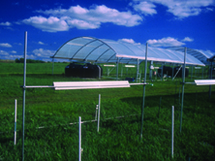Climate change and the Konza
Prairie is a candidate for inclusion in national observation network
K-State grassland holds the potential to help scientists understand the effects of global change on the earth's ecosystems.
 K-State's Konza Prairie Biological Station has been selected as a candidate core site for the proposed National Ecological Observatory Network, also known as NEON. The network is being developed as a continental-scale ecological observation platform, which will have 20 heavily instrumented core sites designed for at least 30 years of intensive measurements. It also includes mobile and airborne ecological sensing systems.
K-State's Konza Prairie Biological Station has been selected as a candidate core site for the proposed National Ecological Observatory Network, also known as NEON. The network is being developed as a continental-scale ecological observation platform, which will have 20 heavily instrumented core sites designed for at least 30 years of intensive measurements. It also includes mobile and airborne ecological sensing systems.
The network is to help researchers over the next 30 years or more to understand and forecast the effects of contemporary global changes -- including climate change, land-use change and invasive species -- on ecosystems as diverse as grasslands, deserts and forests.
The network is being planned with support from the National Science Foundation, and it is the first initiative in the biological sciences being considered for funding through the foundation's major research equipment and facilities construction portfolio, a fund that has built telescope arrays, neutrino detectors and ocean research vessels. In May, the National Science Foundation approved two cooperative agreements with the network's national office totaling $24 million to complete the design and development of the project as it prepares for its final review.
Konza Prairie was selected as the candidate core site to represent native grassland ecosystems in the central U.S. Prairie Peninsula region. Konza is jointly owned by K-State and the Nature Conservancy, and it is managed by the K-State Division of Biology. The NEON planning effort for Konza has been led by K-State's John Blair, university distinguished professor of biology, and Leonard Krishtalka, professor of ecology and evolutionary biology and director of the Biodiversity Institute at the University of Kansas. The planning has involved numerous scientists across both campuses and collaborators at other institutions.
Konza Prairie's ecological diversity and native grasslands, combined with its proximity to human activity, makes it an ideal location to study environmental change, Blair said.
"The Konza site includes native tallgrass prairie habitat, with fire and large native herbivores incorporated into a watershed-level experimental design, as well as areas influenced by contemporary land-use practices like agriculture, prescribed burning and cattle grazing," Blair said. "Konza Prairie also includes intensively monitored stream sites and wells for groundwater sampling."
The advanced monitoring equipment and new measurements that would come as part of the National Ecological Observatory Network would greatly increase the research capabilities of the site. In addition, Blair said that Konza already has a 30-year database of ecological measurements through the National Science Foundation's Long-Term Ecological Research Program.
By serving as a wildland site for the Prairie Peninsula domain, Konza would be a benchmark for evaluating environmental change in the region, and it would serve as an important node in the continental-scale observatory. The results would be relevant to similar grasslands worldwide.
Being a part of the network also would give K-State students and researchers opportunities to collaborate with scientists from across the country, Blair said.
Photo: Measuring the potential effects of climate change on the tallgrass prairie requires long-term experiments such as this one set up on the Konza. Photo courtesy of John Blair.